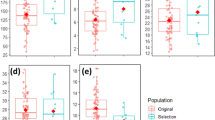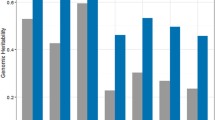Abstract
In practice, progeny and individual palm selection are believed to be the most suitable breeding approach for improvement of quantitative traits in oil palm because their phenotypic expressions are strongly influenced by abiotic factors. Therefore progeny selection approach was applied in this study for the selection of high fresh fruit bunch (FFB) and dwarf oil palm planting materials. Cross between Deli dura and Nigerian pisifera resulted into 34 D × P full sib progenies with 1036 seedlings. For six consecutive years, data were collected on yield and yield component traits, while vegetative traits were recorded once. Bi-parental analysis was carried out using analysis of variance, followed by progenies mean comparison, variance components, heritabilities and cluster analysis. Highly significant (P ≤ 0.01) progeny effect was recorded in this study and this had a pronounced effect on the expression of all the quantitative traits. Progenies performance of FFB varied significantly and it ranged from 166.49 to 220.06 kg/palm/year (kg/p/yr) with trial mean of 192.93 kg/p/yr. Palm height after 8 years of field planting ranged from 1.67 to 2.78 m (control cross) with trial mean of 2.12 m. Broad sense heritability (\({\text{h}}_{\text{B}}^{2}\)) was found to be very low (<17.60%) for all the yield traits, however this parameter was high for vegetative traits with palm height having \({\text{h}}_{\text{B}}^{2}\) of 90%. Cluster analysis based on all the quantitative traits grouped all the 34 DP progenies into nine distinct clusters. From this study, five progenies (DP3, DP4, DP5, DP8 and DP24) were identified to be high yielding and dwarf palms compare to trial mean. At density of 140 palm/ha, they will produce FFB of 28.63–30.81 t/ha and average of 29.69 t/ha which is about 27.15% higher in FFB when compared to the current planting material with FFB of 23.35 t/ha. In addition, the selected progenies possessed average annual palm increment of 29.82 cm/yr with range of 26 and 32.5 cm/yr which was 57.33% shorter than the current planting material with palm height increment of 45–75 cm/yr.

Similar content being viewed by others
References
Arolu IW, Rafii MY, Marjuni M et al (2016) Genetic variability analysis and selection of pisifera palms for commercial production of high yielding and dwarf oil palm planting materials. Ind Crops Prod. doi:10.1016/j.indcrop.2016.06.006x
Bakoumé C, Galima M, Tengoua FF (2011) Experimental modification of reciprocal recurrent selection in oil palm breeding in Cameroon. Euphytica 171:235–240
Barcelos E, de Almeida Rios S, Cunha RNV et al (2015) Oil palm natural diversity and the potential for yield improvement. Front Plant Sci 6:1–16. doi:10.3389/fpls.2015.00190
Blaak G, Sparnaaij L, Mendez T (1963) Breeding and inheritance in oil palm (E. guineensis Jacq.) II. Method of bunch quality analysis. J West Afr Inst Oil Palm Res 4:145–146
Breure CJ (2010) Rate of leaf expansion: a criterion for identifying oil palm (Elaeis guineensis Jacq.) types suitable for planting at high densities. NJAS-Wagen J Life Sci 57:141–147
Breure CJ, Powell MS (1988) The one-shot method of establishing growth parameters in oil palm. In: Hassan AH, Chew PS, Wood BJ, Pusparajah E (eds) Proceedings of the 1987 international oil palm conference agriculture. Palm Oil Research Institute of Malaysia, pp 203–209
Comstock RE, Robinson HF (1948) The components of genetic variance in populations of biparental progenies and their use in estimating the average degree of dominance. Biometrics 4(4):254–266
Corley RHV (2003) Oil palm: a major tropical crop. Burotrop Bull 19:5–8
Corley R, Tinker P (2015) The oil palm, 5th edn. Blackwell Publishing Ltd, Hoboken
Corley RHV, Hardon JJ, Tang Y, Tan G (1971) Analysis of growth of the oil palm (Elaeis guineensis Jacq.) I. Estimation of growth parameters and application in breeding. Euphytica 20:307–315. doi:10.1007/BF00056093
Darby S (2014) Palm oil facts and figures. April 2014, 2012
Davidson L (1991) Management for efficient cost-effective and productive oil palm plantations. In PORIM international conference progress prospects challenges towards the 21st century September 9-14 Kuala Lumpur (No. D-0565). Unilever Plantation
Donough CR, Witt C, Fairhurst TH (2009) Yield intensification in oil palm plantations through best management practice. Better Crops 93:12–14
Falconer DS, Mackay TF (1996) Introduction to quantitative genetics, 4th edn. Pearson Education Ltd, Essex
Fujino Y, Murata H, Mayama C, Asaoka R (2015) A review on mating designs. Nat Sci 13:98–105
Junaidah J, Rafii MY, Chin CW, Saleh G (2011) Performance of tenera oil palm population derived from crosses between Deli dura and Pisifera from different sources on inland soils. J Oil Palm Res 23:1210–1221
Khan M (2015) QTL mapping: a tool for improvement in crop plants. Res J Recent Sci 4(IVC-2015):7–12
Lim TW (1999) Performance of PORIM Nigerian genetic materials at EPA. In: Rajanaidu N, Jalani BS (eds) Proceedings of seminar on PS1 and PS2 oil palm planting materials. Palm Oil Research Institute of Malaysia, Bandar Baru Bangi, Selangor, pp 65–72
Ma L, Kushairi A, Rajanaidu N, Hassan MS (2015) Expert opinion on environmental biology multivariate analysis of vegetative and physiological traits in oil palm (Elaies guineensis Jacq.) germplasm. Expert Opin Environ Biol 4:1–5
Malaysian Standard (2005) MS157:2005 Oil palm seeds for commercial planting specification (Third Revision). Department of Standards Malaysia, pp 1–14
Marhalil M, Rafii MY, Afizi MMA et al (2013) Genetic variability in yield and vegetative traits in elite germplasm of MPOB-Nigerian dura × AVROS pisifera progenies. J Food Agric Environ 11:515–519
Mohd Din A, Rajanaidu N, Kushairi A, Tarmizi AH, Noh A, Marhalil M, Zulkifli Y, Norziha A, Meilina OA, Ravigadevi S (2014) Performance and yield potential of oil palm planting materials. Planter 90(1065):881–904
Murphy DJ (2014) The future of oil palm as a major global crop: opportunities and challenges. J Oil Palm Res 26:1–24
Nduwumuremyi A, Tongoona P, Habimana S (2013) Mating designs: helpful tool for quantitative plant breeding analysis. J Plant Breed Genet 1:117–129
Noh A, Rafii MY, Din AM et al (2014) Variability and performance evaluation of introgressed Nigerian dura × Deli dura oil palm progenies. Genet Mol Res 13:2426–2437. doi:10.4238/2014.April.3.15
Obisesan IO, Fatunla T (1982) Heritability of fresh fruit bunch yield and its components in the oil palm (Elaeis guineensis Jacq.). Theor Appl Genet 64:65–68. doi:10.1007/BF00303653
Rafii MY, Isa ZA, Kushairi A et al (2013) Variation in yield components and vegetative traits in Malaysian oil palm (Elaeis guineensis Jacq.) dura × pisifera hybrids under various planting densities. Ind Crops Prod 46:147–157. doi:10.1016/j.indcrop.2012.12.054
Rajanaidu N, Ainul MM (2013) Conservation of oil plam and coconut genetic resources. In: Normah MN, Chin HF, Reed BM (eds) Conservation of tropical plant species. Springer, New York, pp 189–212
Rajanaidu N, Arasu N, Obasola C (1979) Collection of oil palm (Elaies guineesis Jacq.) genetic materials in Nigeria II. Phenotypic variation of natural population. MARDI Res Bull 7:1–27
Rajanaidu N, Jalani BS, Kushairi A et al (1999) Breeding strategies for the oil palm planting materials PS1 and PS2 and the future PS series. In: Rajanaidu N, Jalani BS (eds) Proceedings of seminar on PS1 and PS2 oil palm planting materials. Palm Oil Research Institute of Malaysia, Bandar Baru Bangi, Selangor, pp 76–90
Rajanaidu N, Kushairi A, Rafii M et al (2000) Oil palm genetic resources and their utilization: a review. In: Rajanaidu N, Ariffin D (eds) Proceedings of international symposium on oil palm genetic resources and their utilization. MPOB, Kuala Lumpur, Malaysia, pp 34–80
Rao V, Soh AC, Corley RHV, Lee CH, Rajanaidu N (1983) Critical re-examination of the method of bunch quality analysis in oil palm breeding. PORIM Occasional Paper-Palm Oil Research Institute of Malaysia
Sharma M (1999) Utilization of Nigerian PS1 and PS2 selection in oil palm breeding programmes at UP BHD. In: Rajanaidu N, Jalani BS (eds) Proceedings of seminar on PS1 and PS2 oil palm planting materials. Palm Oil Research Institute of Malaysia, Bandar Baru Bangi, Selangor, pp 18–29
Soh AC, Rajanaidu N, Hor TY, Gan HH (1999) Combining abilities of selected parents of PORIM’s Nigerian oil palm prospection in introgressed progenies with AAR’s advanced breeding parents In: Rajanaidu N, Jalani BS (eds) Proceedings of seminar on PS1 and PS2 oil palm planting materials. Palm Oil Research Institute of Malaysia, Bandar Baru Bangi, Selangor, pp 30–53
Sunilkumar K, Mathur RK, Sparjanbabu DS, Pillai RSN (2015) Evaluation of interspecific oil palm hybrids for dwarfness. J Plant Crop 43:29–34
USDA (2016) Oil seeds: world markets and trade. Foreign agricultural service, circular series, FOP 8–10. http://apps.fas.usda.gov/psdonline/circulars/oilseeds.pdf
Acknowledgements
The authors wish to thank Malaysian Palm Oil Board (MPOB), Kulim (M) Berhad, United Malacca Berhad and Universiti Putra Malaysia (UPM) for providing research materials, facilities and financial support to carry out this study.
Author information
Authors and Affiliations
Corresponding author
Rights and permissions
About this article
Cite this article
Arolu, I.W., Rafii, M.Y., Marjuni, M. et al. Breeding of high yielding and dwarf oil palm planting materials using Deli dura × Nigerian pisifera population. Euphytica 213, 154 (2017). https://doi.org/10.1007/s10681-017-1943-z
Received:
Accepted:
Published:
DOI: https://doi.org/10.1007/s10681-017-1943-z




